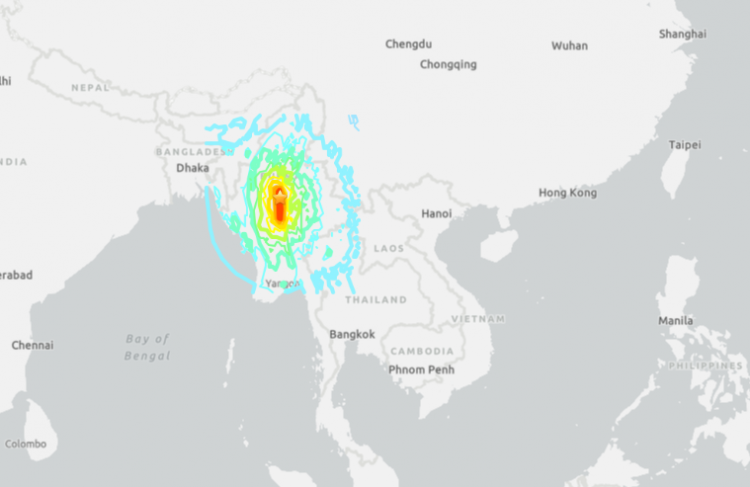A massive 7.7 magnitude earthquake struck central Myanmar on Friday, shaking buildings across Southeast Asia and causing widespread destruction in both Myanmar and Thailand. The tremor triggered the collapse of a high-rise building under construction in Bangkok, killing at least three people and leaving dozens missing, as rescue operations continue in unstable debris.
Thai Defense Minister Phumtham Wechayachai said 90 people are unaccounted for at the Bangkok construction site, located near the bustling Chatuchak market. A crane-topped multistory structure was seen in viral footage collapsing into a cloud of dust, while screams and sirens filled the area. "Three people were killed at the site," Wechayachai confirmed, including a construction worker hit by falling debris.
The U.S. Geological Survey reported the earthquake originated near Mandalay, Myanmar's second-largest city, at a shallow depth of just 6.2 miles, a factor that often amplifies destructive force. A strong 6.4 aftershock followed shortly after.
Bangkok's city hall declared the capital a disaster area to expedite emergency coordination. Public transportation systems, including subways and elevated trains, were halted as panicked residents and tourists fled high-rise buildings.
"All of a sudden the whole building began to move. Immediately there was screaming and a lot of panic," said Fraser Morton, a Scottish tourist shopping in a mall at the time. "People were running the wrong way down escalators, lots of banging and crashing inside the mall."
Similar accounts emerged from across the city. "In my lifetime, there was no earthquake like this in Bangkok," said Voranoot Thirawat, a lawyer who evacuated her 12th-floor office after seeing lights swinging and hearing creaking walls.
The greater Bangkok area, home to over 17 million people, is unaccustomed to such large seismic events. While the region is near fault lines, earthquakes of this magnitude are rare.
In Myanmar, where government communications remain limited due to an ongoing civil war, early reports indicated substantial damage. Parts of Mandalay's historic royal palace were damaged, and homes and religious shrines collapsed in the capital, Naypyitaw. In the Sagaing region, a 90-year-old bridge failed and sections of the highway connecting Mandalay to Yangon were severely affected.
Maj. Gen. Zaw Min Tun, spokesman for Myanmar's military government, told MRTV that blood donations were urgently needed in Mandalay, Naypyitaw, and Sagaing.
The Red Cross reported that fallen power lines and impassable roads were complicating response efforts in some regions. "Initial reports from the ground suggest the earthquake has caused significant damage," the organization stated.
Across the border, China also felt the quake's impact. The Xinhua News Agency reported at least 188 injuries in Tibet and structural damage in Ruili, a city near the Myanmar border. Chinese state media shared video footage of emergency responders transporting injured civilians through streets littered with debris.
In Thailand, rooftop pools spilled water and high-rises visibly swayed. April Kanichawanakul, who works in Bangkok's city center, said, "I just thought I was dizzy," until her entire office began moving. She and coworkers fled the building and waited for safety instructions.
Prime Minister Paetongtarn Shinawatra convened an emergency meeting with Thailand's Department of Disaster Prevention, which reported the quake was felt in nearly all parts of the country. Residents were advised to remain outside due to the potential for further aftershocks.






